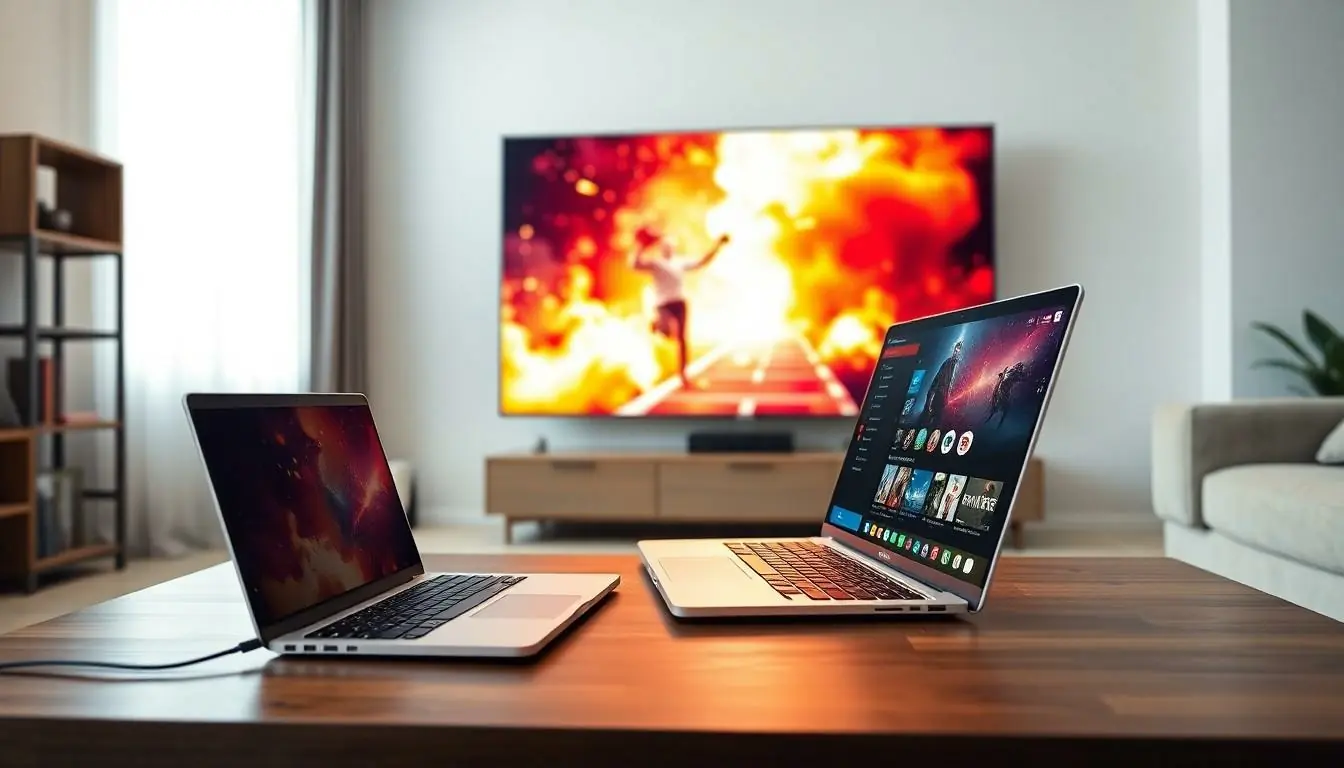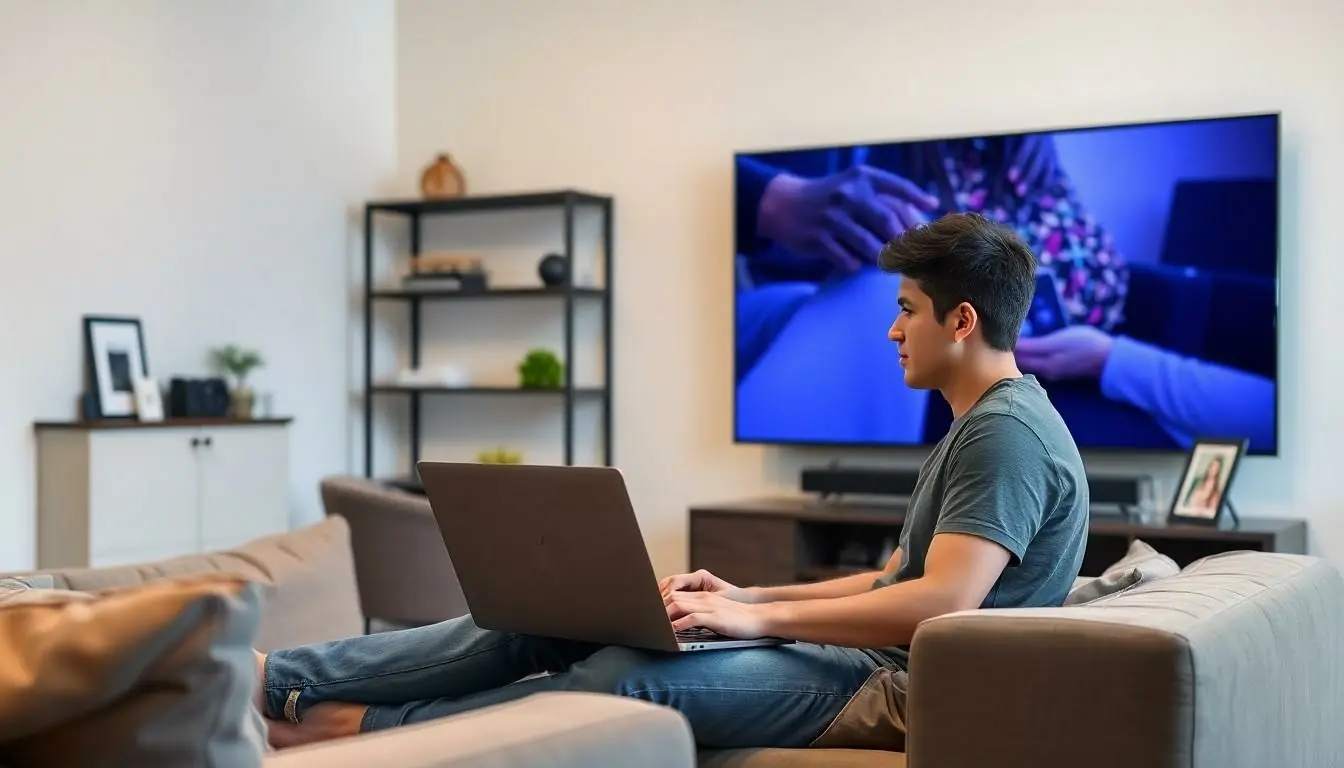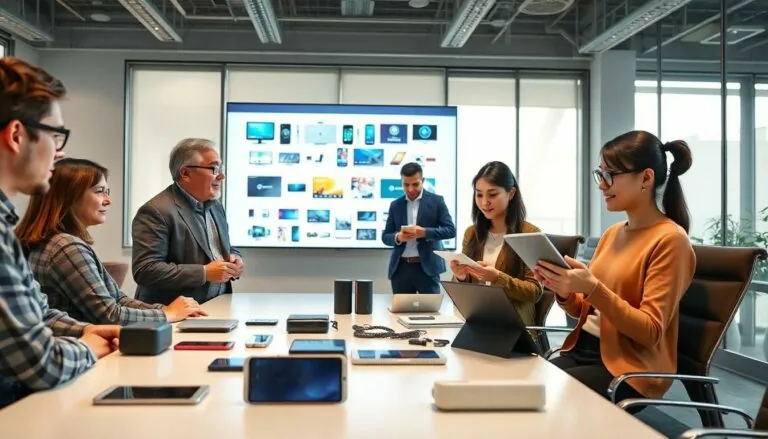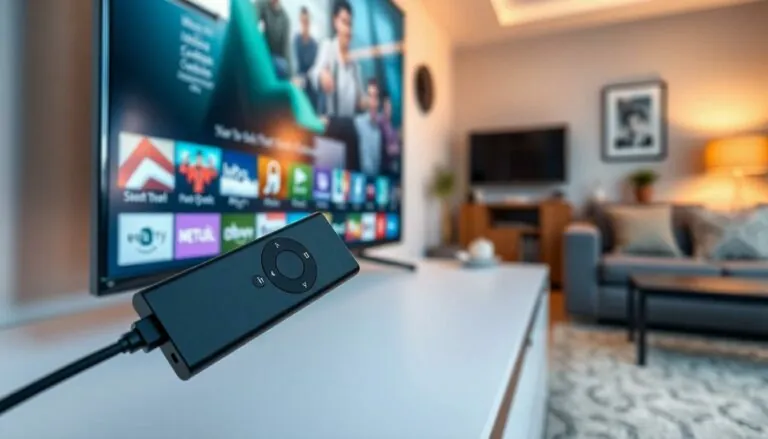Imagine transforming your laptop into a cinematic powerhouse right in your living room. Whether it’s binge-watching the latest series or showcasing your epic vacation photos, displaying your laptop on a TV can elevate your entertainment experience. Gone are the days of squinting at a small screen—now it’s time to go big!
Table of Contents
ToggleUnderstanding the Need to Display Laptop on TV
Connecting a laptop to a TV serves various purposes that enhance user experience. For instance, streaming movies or shows becomes more enjoyable on a large screen. Many users find it ideal for sharing presentations during meetings or significant events. Gaming on a larger display also adds excitement, elevating competitive gameplay.
Parents often use this setup to showcase family photos during gatherings, creating lasting memories. Viewing educational content on a larger screen is beneficial for students, aiding in better focus during lessons or tutorials. Those wishing to do video calls find that using a TV provides a more engaging way to connect with loved ones.
The versatility of this feature appeals to various interests, from casual users to professionals. Individuals can utilize this connection for streaming services, online courses, or social media. All these uses contribute significantly to comfort and enjoyment.
Moreover, understanding the technical aspects of connecting a laptop to a TV ensures a smoother experience. Knowledge of different connection types, such as HDMI, VGA, or wireless methods, helps in selecting the best option for specific needs. Some devices support both audio and video, simplifying the setup.
Emphasizing the importance of this connection addresses practical benefits that extend beyond simple convenience. Utilizing a large display leads to better ergonomics, reducing strain during extended viewing sessions. Consistent use of a laptop connected to a TV enhances both productivity and entertainment, proving crucial in today’s digital landscape.
Different Methods to Connect Laptop to TV

Connecting a laptop to a TV can occur through various methods. Each method provides unique advantages depending on specific needs.
HDMI Connection
HDMI stands as the most common connection type for laptops and TVs. Using an HDMI cable allows for both video and audio transmission, simplifying the setup process. Most laptops and modern TVs feature HDMI ports, making this method widely accessible. Users need to connect one end of the cable to the laptop and the other to the TV. Selecting the correct HDMI input on the TV often displays the laptop screen instantly. This approach delivers high-definition quality, benefiting gamers and movie lovers alike.
Wireless Display Options
Wireless display options provide a cable-free method to connect laptops to TVs. Devices like Chromecast and Apple TV facilitate this function, allowing screens to mirror without physical connections. Users download an app or configure their laptops to connect wirelessly. Screen sharing applications can also assist, enabling presentations and multimedia playback. Wireless connections often support high-definition content but may experience slight latency. This method enhances convenience, particularly in clutter-free setups.
Troubleshooting Common Issues
Encountering issues when connecting a laptop to a TV can disrupt the viewing experience. Below are common problems and their solutions.
No Signal from Laptop
No signal from the laptop often indicates a connection problem. Check that the correct input source is selected on the TV. A loose cable might also cause this issue; ensure that the HDMI or VGA cable is firmly connected to both devices. Restarting both the laptop and TV can sometimes resolve the no signal error. If using a wireless connection, ensure that both devices are on the same Wi-Fi network. Updating display drivers on the laptop may also help re-establish the connection.
Poor Quality Display
Poor quality display usually signifies resolution or connection issues. Incorrect resolution settings on the laptop may lead to blurry images. Adjusting the output resolution to match the TV’s native resolution can enhance clarity. In some cases, using an HDMI cable instead of VGA may yield better quality since HDMI supports higher definitions. Also, ensure that the cable is not damaged. Lastly, checking for interferences with wireless connections might improve display performance if connected wirelessly.
Tips for Optimizing Your Display Experience
Adjusting display settings enhances visual quality when connecting a laptop to a TV. Check resolution options first. Setting the laptop’s output resolution to match the TV’s native resolution improves clarity.
Utilizing the correct input source is vital. Ensure the TV is set to the right HDMI or VGA input for a seamless experience. Switching inputs often resolves connection issues quickly.
For wireless connections, keep the distance between the laptop and the receiver minimal. Reducing distance minimizes latency, ensuring smoother streaming and better responsiveness during presentations.
Managing sound settings is also important. Amplifying audio on the TV while lowering the laptop’s volume prevents echo and ensures clearer sound during movie nights or video calls.
Using the right cables can make a difference. High-quality HDMI cables support higher resolutions and frame rates, promoting superior image quality. Investing in reliable cables can prevent signal interference and connection problems.
Consider arranging digital devices strategically. Placing the laptop near the TV reduces cable clutter and makes controlling both devices easier. This setup enhances accessibility during use.
Updating drivers is another step to optimize performance. Keeping display and audio drivers current can resolve compatibility issues and enhance the overall functionality of the connection.
Lastly, adjusting TV picture settings such as brightness and contrast further fine-tunes the viewing experience. Finding the right balance enhances color accuracy and image sharpness, making visual content more engaging.
Taking these actions optimizes the display experience when connecting a laptop to a TV, ensuring an enjoyable viewing experience across different activities.
Connecting a laptop to a TV opens up a world of possibilities for entertainment and productivity. It transforms small screens into expansive displays perfect for streaming movies, sharing presentations, or enjoying family photos. The wide array of connection methods, both wired and wireless, ensures that there’s a solution for every setup.
By understanding the technical details and troubleshooting common issues, users can create a seamless experience. With the right adjustments to display settings and sound management, the viewing experience can be significantly enhanced. Embracing this technology not only boosts enjoyment but also elevates everyday tasks, making it an essential skill in today’s digital age.





